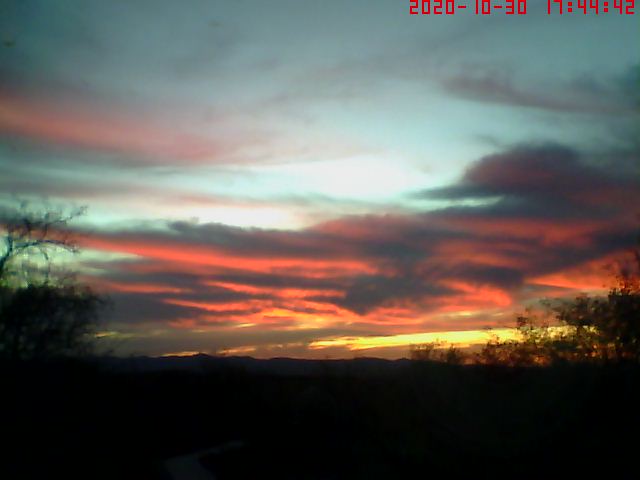Piggyback imaging: Heart & Soul Nebulae, the Pleiades
Posted: 5 November 2020
Mid-day on Friday, 30 October 2020, clouds began arriving, providing some nice sunsets.


Cloudy skies continued until Wednesday, 4 November.
|
Open: Wednesday, 4 November 2020, 1809 MST Temperature: 84°F |
Session: 1549 Conditions: Clear |
Equipment:
12" f/8 LX600 w/StarLock
2" 24mm UWA eyepiece
2" 9mm 100° eyepiece
Camera:
D7200 DSLR
1813 MST: LX600 ON, StarLock OFF, High Precision OFF.
Viewed Jupiter and 4 moons, 102X. Viewed Saturn and 2 moons, 102X. Viewed Mars, 102X.
Next, viewed Saturn and Jupiter, 12x50 binoculars. Both planets were visible in the same 4.6° field-of-view (barely).
I then began preparing for piggyback imaging. Removed one of the two finderscopes from the dual finderscope bracket.
1832-1848 MST: relaxed on the observatory patio bench to watch the stars come out.
I then took this handheld D7200 DSLR photo (f/3.5, 1 seconds, ISO 6400, White Balance Auto, FL 18mm) of the southwestern sky showing Saturn and Jupiter near the "teapot" of the constellation of Sagittarius. Some clouds were low on the horizon and the Milky Way is just barely visible to the right of the teapot.

Mouseover or tap on image for labels
I then mounted the D7200 DSLR with 18-140mm lens piggyback on the LX600. I SYNCed the AutoStar to the star Mirach with the camera view. I attached the Optolong Hydrogen-Alpha filter to the camera lens using Sensei Step-Down Rings. I focused the lens using the planet Mars as I needed a bright object to focus.
Turned High Precision ON and slewed to IC1805 (Heart Nebula). I could not see the centering star with the HA filter attached so I removed it. I could then see the star.
1921 MST: StarLock ON.
I then began doing StarLock autoguided images of the Heart and Soul Nebulae using the HA and Explore Scientific UHC filters. I refocused the lens using Mars when I switched to the UHC filter. Had to remove the filter to see the alignment star when I returned to IC1805. Here are the unedited HA (f/5.6, 5 minutes, ISO 6400, WB 4000K, FL 140mm) and UHC (f/5.6, 10 minutes, ISO 6400, WB 4000K, FL 140mm) images. The Heart Nebula is centered with the Soul Nebula at the right.


I merged the two images in Photoshop. Here is the (cropped) result:

2008 MST: High Precision OFF.
I then imaged M45 (the Pleiades), StarLock autoguided, UHC filter (f/5.6, 10 minutes, ISO 6400, WB 4000K, FL 140mm). This is the (cropped) result.

2031 MST: StarLock OFF.
The eastern sky was brightening from the rising waning gibbous Moon.
I then checked the lens with the step-down rings attached to see if there was any significant reduction in the size of the aperture opening that would affect the f/ ratio. There wasn't. But then I noticed that I had forgot to turn Vibration Reduction OFF for the piggyback images. Oops. That's why there is some trailing visible in the M45 image.
Remounted the finderscope. SYNCed on the star Aldebaran and checked the finderscope alignment (which was OK).
2106 MST: viewed Mars, 102X and 271X. The view at 271X was very nice with the North Polar Hood and the small bright South Polar Ice Cap visible.
2108 MST: LX600 OFF.
|
Close: Wednesday, 4 November 2020, 2116 MST Temperature: 67°F |
Session Length: 3h 07m Conditions: Clear |
Comments are welcome using Email. Twitter users can use the button below to tweet this report to their followers. Thanks.
Cassiopeia Observatory Home Page
Copyright ©2020 Michael L. Weasner / mweasner@me.com
URL = http://www.weasner.com/co/Reports/2020/11/05/index.html
